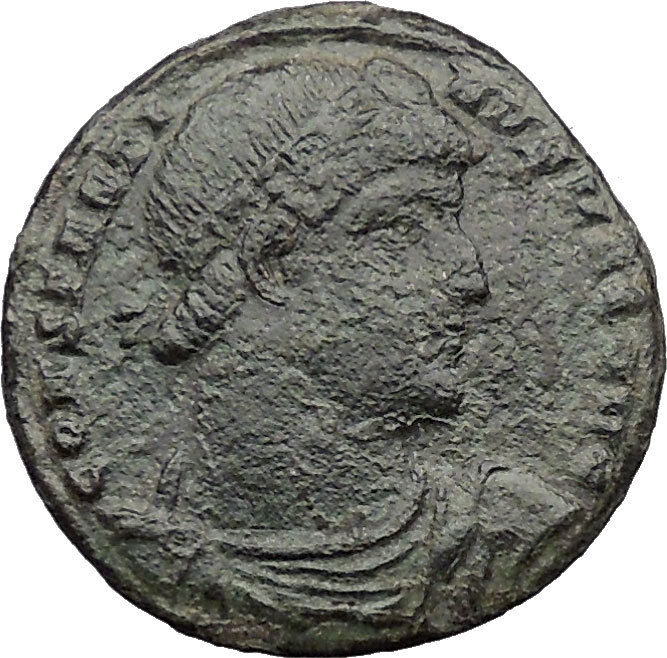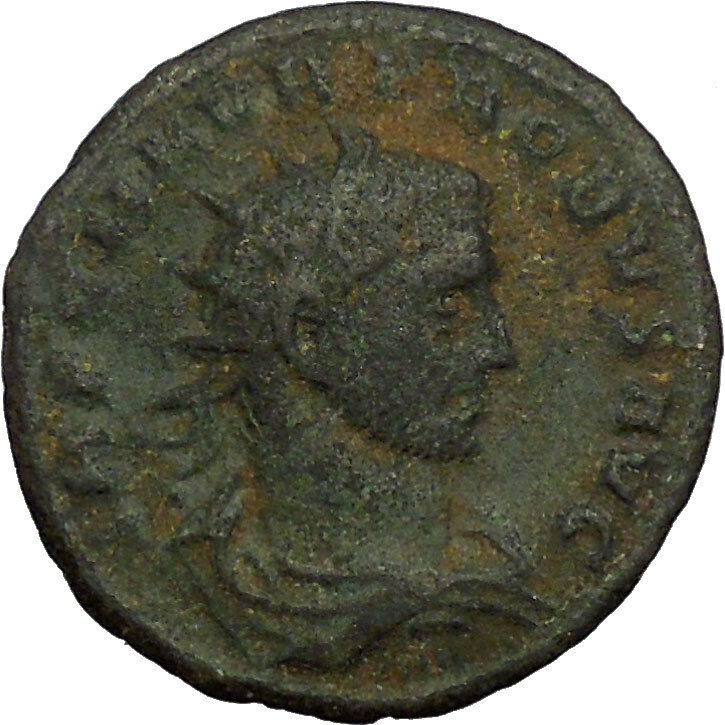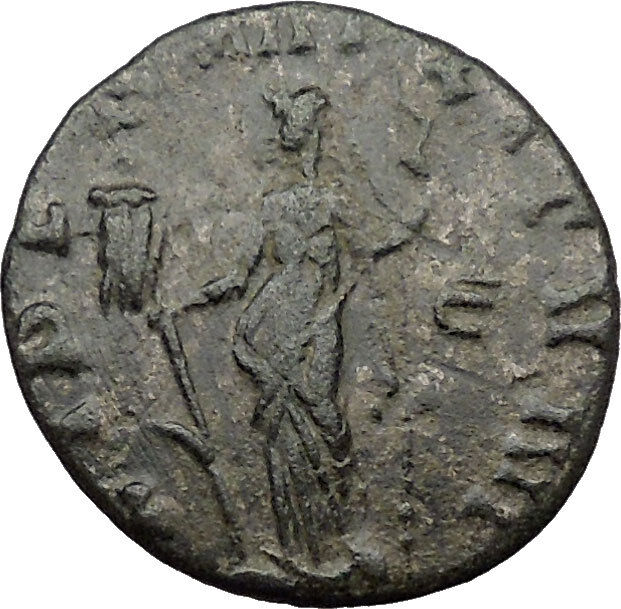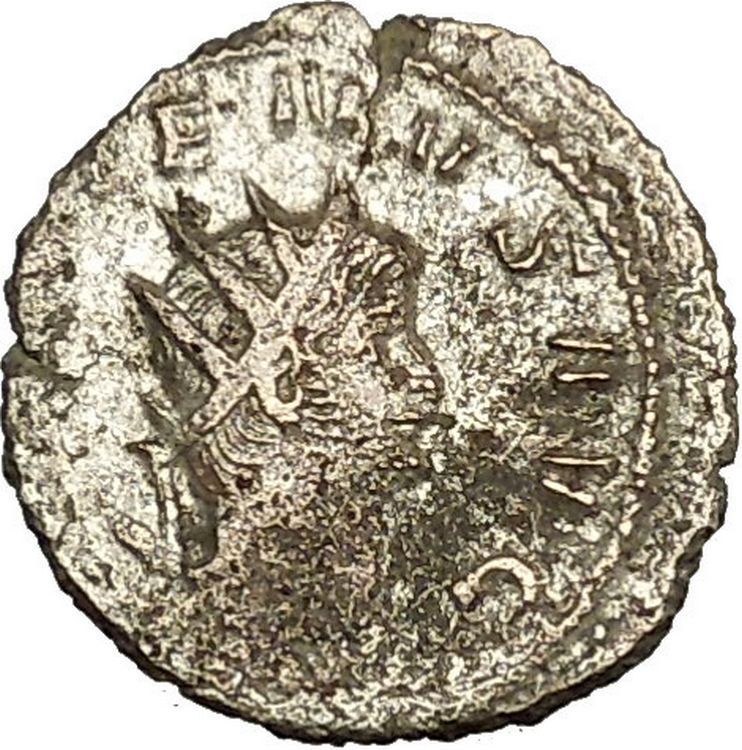|
Gordian III –
Roman Emperor
: 238-244 A.D. –
Silver Denarius 19mm (3.10 grams) Rome mint: 240 A.D.
Reference: RIC 127, C 69
IMPGORDIANVSPIVSFELAVG – Laureate, draped and cuirassed bust right.
DIANALVCIFERA – Diana standing right, holding torch with both hands.
You are bidding on the exact
item pictured, provided with a Certificate of Authenticity and Lifetime
Guarantee of Authenticity.
In
ancient Roman religion
and
myth
, Luna is the divine embodiment of
the Moon (Latin luna; cf. English “lunar”). She is often presented as the
female complement of the Sun (Sol) conceived of as a god. Luna is also
sometimes represented as an aspect of the Roman triple goddess (diva
triformis), along with
Proserpina
and
Hecate
. Luna is not always a distinct
goddess, but sometimes rather an
epithet
that specializes a goddess, since both
Diana
and
Juno
are identified as moon goddesses.
In
Roman art
, Luna’s attributes are the crescent
moon and the two-yoke chariot (biga).
In the
Carmen Saeculare
, performed in 17 BC,
Horace
invokes her as the “two-horned queen of
the stars” (siderum regina bicornis), bidding her to listen to the girls
singing as Apollo
listens to the boys.
Varro
categorized Luna and Sol among the
visible gods, as distinguished from invisible gods such as
Neptune
, and deified mortals such as
Hercules
. She was one of the deities
Macrobius
proposed as the secret
tutelary
of Rome. In
Imperial cult
, Sol and Luna can represent the
extent of Roman rule over the world, with the aim of guaranteeing
peace
.
Luna’s
Greek counterpart
was
Selene
. In Roman art and
literature
, myths of Selene are adapted under
the name of Luna. The myth of
Endymion
, for instance, was a popular subject
for Roman wall painting.
Temples and cult
Luna had a temple on the
Aventine Hill
, just below a temple of Diana. As
Noctiluna (“Night-Shiner”) she had a temple on the
Palatine Hill
.
Titus Tatius
was supposed to have imported the
cult of Luna to Rome from the
Sabines
.
Varro
lists Luna among twelve deities who are
vital to
agriculture
, as does
Vergil
in a different list of twelve, in which
he refers to Luna and Sol as clarissima mundi lumina, the world’s
clearest sources of light.
Varro also lists Luna among twenty principal gods of Rome (di
selecti). In this list, Luna is distinguished from both Diana and Juno, who
also appear on it.
Juno as moon goddess
The
Kalends
of every month, when according to the
lunar calendar
the new moon occurred, was
sacred to Juno, as all
Ides
were to
Jupiter
.
On the
Nones
, she was honored as Juno Covella, Juno of
the crescent moon. Both Juno and Diana were invoked as
childbirth goddesses
with the epithet
Lucina
.
Chariot of the moon
In this
relief
depicting a Mithraic
tauroctony
, Luna drives a
biga drawn by oxen (right), while the Sun drives a
horse-drawn quadriga (left)
Luna (top right corner) paired with the Sun (top left) in
another depiction of the tauroctony
Luna is often depicted driving a two-yoke chariot (biga),
drawn by horses or oxen. In Roman art, the charioteer Luna is regularly paired
with the Sun driving a four-horse chariot (quadriga).
Isidore of Seville
explains that the
quadriga
represents the sun’s course
through the four seasons, while the biga represents the moon, “because it
travels on a twin course with the sun, or because it is visible both by day and
by night—for they yoke together one black horse and one white.”
Luna in her biga was an element of
Mithraic
iconography, usually in the context of
the tauroctony
. In the
mithraeum
of S. Maria Capua Vetere, a wall
painting that uniquely focuses on Luna alone shows one of the horses of the team
as light in color, with the other a dark brown.
A biga of oxen was also driven by
Hecate
, the
chthonic
aspect of the triple goddess in
complement with the “horned” or crescent-crowned
Diana
and Luna. The three-form Hecate (trimorphos)
was identified by
Servius
with Luna, Diana, and
Proserpina
. According to the
Archaic Greek
poet
Hesiod
, Hecate originally had power over the
heavens, land, and sea, not as in the later tradition heaven, earth, and
underworld.
Diana
(lt. “heavenly” or “divine”) was the goddess of the
hunt
, being associated with wild animals and
woodland, and also of the
moon in
Roman mythology
. In

literature she was the
equal
of the
Greek goddess
Artemis
, though in
cult beliefs
she was
Italic
, not Greek, in origin. Diana was
worshiped in
ancient Roman religion
and is currently revered
in Roman Neopaganism
and
Stregheria
. Dianic Wicca, a largely feminist
form of the practice, is named for her. Diana was known to be the virgin goddess
and looked after virgins and women. She was one of the three maiden goddesses,
Diana, Minerva and Vesta, who swore never to marry. Along with her main
attributes, Diana was an emblem of
chastity
.
Oak
groves were especially sacred to her. According to mythology, Diana was born
with her twin
brother
Apollo
on the island of
Delos
, daughter of
Jupiter
and
Latona. Diana made up a triad with two other Roman deities:
Egeria
the water nymph, her servant and
assistant midwife; and
Virbius
, the woodland god.
Marcus Antonius Gordianus Pius (January
20, 225
–
February
11
, 244
),
known in
English
as Gordian III,
 was was
Roman
Emperor
from 238 to 244. Gordian was the son of
Antonia Gordiana
and his father was an unnamed Roman Senator who died before
238. Antonia Gordiana was the daughter of Emperor
Gordian I
and younger sister of Emperor
Gordian II
.
Very little is known on his early life before becoming Roman Emperor. Gordian
had assumed the name of his maternal grandfather in 238.
Following the murder of emperor
Alexander Severus
in Moguntiacum (modern
Mainz
), the
capital of the
Roman province
Germania Inferior
,
Maximinus Thrax
was acclaimed emperor, despite strong opposition of the
Roman senate
and the majority of the population. In response to what was
considered in Rome as a rebellion, Gordian’s grandfather and uncle, Gordian I
and II, were proclaimed joint emperors in the
Africa Province
. Their revolt was suppressed within a month by Cappellianus,
governor of Numidia
and a loyal supporter of Maximinus Thrax. The elder Gordians died,
but public opinion cherished their memory as peace loving and literate men,
victims of Maximinus’ oppression.
Meanwhile, Maximinus was on the verge of marching on Rome and
the Senate elected
Pupienus
and Balbinus
as joint emperors. These senators were not popular men and the population of
Rome was still shocked by the elder Gordian’s fate, so that the Senate decided
to take the teenager Gordian, rename him Marcus Antonius Gordianus as his
grandfather, and raise him to the rank of
Caesar
and imperial heir.
Pupienus
and Balbinus
defeated Maximinus, mainly due to the defection of several
legions
,
namely the
Parthica II
who assassinated Maximinus. But their joint reign was
doomed from the start with popular riots, military discontent and even an
enormous fire that consumed Rome in June 238. On
July 29
,
Pupienus and Balbinus were killed by the
Praetorian guard
and Gordian proclaimed sole emperor.
Rule
Due to Gordian’s age, the imperial government was surrendered
to the aristocratic families, who controlled the affairs of Rome through the
senate. In 240,
Sabinianus
revolted in the African province, but the situation was dealt quickly. In 241,
Gordian was married to Furia Sabinia
Tranquillina
, daughter of the newly appointed praetorian prefect,
Timesitheus
. As chief of the Praetorian guard and father in law of the
emperor, Timesitheus quickly became the de facto ruler of the Roman
empire.
In the 3rd century, the Roman frontiers weakened against the
Germanic tribes across the
Rhine
and
Danube
, and the
Sassanid
kingdom across the
Euphrates
increased its own attacks. When the Persians under
Shapur I
invaded Mesopotamia
, the young emperor opened the doors of the
Temple of Janus
for the last time in Roman history, and sent a huge army to
the East. The Sassanids were driven back over the Euphrates and defeated in the
Battle of Resaena
(243). The campaign was a success and Gordian, who had
joined the army, was planning an invasion of the enemy’s territory, when his
father-in-law died in unclear circumstances. Without Timesitheus, the campaign,
and the emperor’s security, were at risk.
Marcus Julius Philippus, also known as
Philip the Arab
, stepped in at this moment as the new Praetorian Prefect and
the campaign proceeded. In the beginning of 244, the Persians counter-attacked.
Persian sources claim that a battle was fought (Battle
of Misiche) near modern
Fallujah
(Iraq)
and resulted in a major Roman defeat and the death of Gordian III[1].
Roman sources do not mention this battle and suggest that Gordian died far away,
upstream of the Euphrates. Although ancient sources often described Philip, who
succeeded Gordian as emperor, as having murdered Gordian at Zaitha (Qalat es
Salihiyah), the cause of Gordian’s death is unknown.
Gordian’s youth and good nature, along with the deaths of his
grandfather and uncle and his own tragic fate at the hands of another usurper,
granted him the everlasting esteem of the Romans. Despite the opposition of the
new emperor, Gordian was deified by the Senate after his death, in order to
appease the population and avoid riots.
|







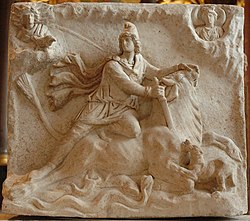

 was
was